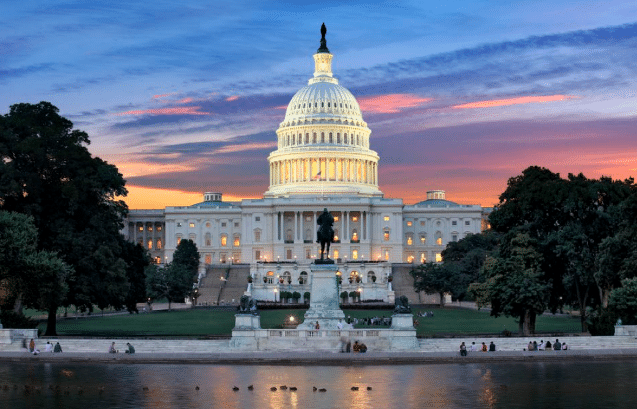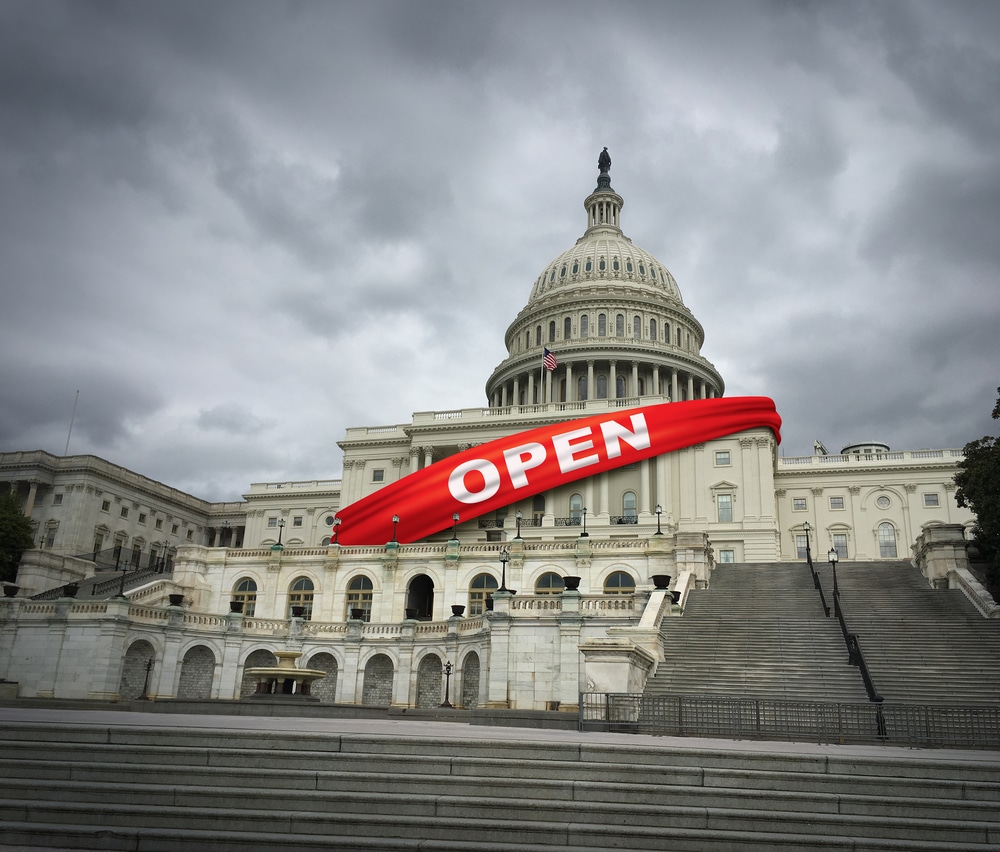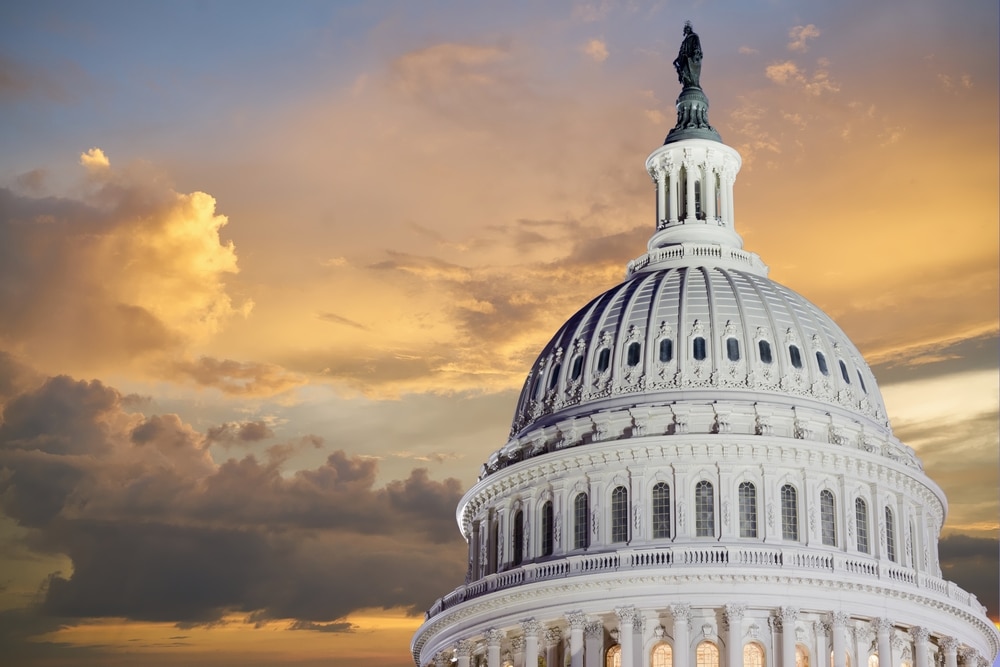07 Jan2022
By Jane E. West
 I write to you with news of a change in Washington Update as we start the new year. After 7 years, I will be stepping away from writing Washington Update and the talented Kaitlyn Brennan will be taking over. As you know, she has been writing with me over the last year. And now it’s time for her to take the helm, as I find time to finish my book, which of course is about policy making.
I write to you with news of a change in Washington Update as we start the new year. After 7 years, I will be stepping away from writing Washington Update and the talented Kaitlyn Brennan will be taking over. As you know, she has been writing with me over the last year. And now it’s time for her to take the helm, as I find time to finish my book, which of course is about policy making.
I began Washington Update in March 2015. I realized that so much happened so fast in the D.C. policy world that I was having a hard time keeping track. And if that was challenging for me, whose day job involved emersion in the D.C. policy world, it must really be hard for you, whose day job keeps you in another sphere.
21 Dec2021
By Jane E. West and Kaitlyn Brennan
This blog post is written by AACTE consultant Jane West and is intended to provide updated information. The views expressed in this post do not necessarily reflect the views of AACTE.

Congress Looks to Head Home for the Holidays Leaving Unfinished Business for Next Year
With the temporary fix to fund the government completed (until February 18) and the debt ceiling extension completed, the one big item left on the agenda for this week for Congress was passing President Biden’s Build Back Better plan. With the House already having passed the bill, the ball was in the Senate court where Majority Leader Schumer (D-NY) had promised a vote before the holidays. That promise evaporated this week as it became clear that it would be impossible to corral all Senate Democrats to vote yes—a requirement for passage. Even after multiple conversations with President Biden and other Senators, Sen. Joe Manchin (D-WV) was unwilling to offer his support for the $1.7 trillion bill. So reluctantly, Senators turned their attention to other matters, such as confirming Biden nominations and considering strategies for securing support for voting rights reform.
14 Dec2021
By Jane E. West and Kaitlyn Brennan
 This blog post is written by AACTE consultant Jane West and is intended to provide updated information. The views expressed in this post do not necessarily reflect the views of AACTE.
This blog post is written by AACTE consultant Jane West and is intended to provide updated information. The views expressed in this post do not necessarily reflect the views of AACTE.
Congress Checks Another Item Off The “Must-Do” List
Last week lawmakers in Congress rallied to unite behind a deal that keeps the government funded at its current levels through February 18 __a Continuing Resolution (CR).This is the first in a series of “must-do” tasks before the New Year. The temporary patch keeps the government open, but it could result in federal agencies delaying grant competitions and disbursement of funds.
06 Dec2021
By Jane E. West and Kaitlyn Brennan
This blog post is written by AACTE consultant Jane West and is intended to provide updated information. The views expressed in this post do not necessarily reflect the views of AACTE.
 It’s the end-of-year countdown season for Congress and a lot is at stake!
It’s the end-of-year countdown season for Congress and a lot is at stake!
Congress Races to the Finish Line
On this past Thursday, just 36 hours before government funding was set to lapse, lawmakers rallied to unite behind a deal that will keep the government funded at its current levels through February 18. The House voted 221-212 to approve the measure. The Senate then passed the 11-week stopgap spending bill in a 69-28 vote—sending the measure to the President’s desk. The legislation, referred to as a continuing resolution (CR), will prevent a government shutdown while keeping the government funded at levels set nearly one year ago by former President Trump.
22 Nov2021
By Jane E. West and Kaitlyn Brennan
 This blog post is written by AACTE consultant Jane West and is intended to provide updated information. The views expressed in this post do not necessarily reflect the views of AACTE.
This blog post is written by AACTE consultant Jane West and is intended to provide updated information. The views expressed in this post do not necessarily reflect the views of AACTE.
Democrats in Congress are taking a victory lap as they leave town for a weeklong Thanksgiving recess next week. With House passage of the Build Back Better Act, the Biden agenda is one step closer to enactment. But the Senate will have the final say.
House Passes Build Back Better Bill – At Last
After weeks of fraught negotiations, and multiple postponed votes, the House finally passed the Build Back Better Act (the reconciliation bill) this morning. One Democrat (Rep. Jared Golden of Maine) sided with all Republicans opposing the bill. This left the Democrats with the slim margin they needed to cross the finish line.
15 Nov2021
By Jane E. West and Kaitlyn Brennan

This blog post is written by AACTE consultant Jane West and is intended to provide updated information. The views expressed in this post do not necessarily reflect the views of AACTE.
While Congress has been out of session this week for a Veteran’s Day recess, the action behind the scenes continues to be dominated by the prospects of finalizing the reconciliation bill, or the Build Back Better plan. Educators are eager to see this make it over the finish line, as it includes important investments for education, including $610 million for the educator pipeline.
Bipartisan Infrastructure Heads to President Biden for Signature
Last Friday, all eyes were on the House of Representatives where Speaker Nancy Pelosi (D-CA) was working overtime to schedule a vote on both the bipartisan infrastructure bill (which had already passed the Senate) and the partisan reconciliation bill (which has passed neither body but is being intensely negotiated behind the scenes). Pelosi could afford to lose only three Democratic votes and still pass the bills.
08 Nov2021
By Jane E. West and Kaitlyn Brennan

This blog post is written by AACTE consultant Jane West and is intended to provide updated information. The views expressed in this post do not necessarily reflect the views of AACTE.
Educators watched closely as local elections around the country provided hints for what may be coming in next year’s Congressional midterms and even the 2024 presidential race. With the victory of Republican Glenn Youngkin for Virginia’s next governor, the spotlight was on education issues—particularly parental voice in local education decisions. Issues like Critical Race Theory (which is not taught in Virginia public schools but used as a proxy for teaching about race), vaccination mandates and school closures, and the rights of transgender students took center stage.
25 Oct2021
By Jane E. West and Kaitlyn Brennan
 This blog post is written by AACTE consultant Jane West and is intended to provide updated information. The views expressed in this post do not necessarily reflect the views of AACTE.
This blog post is written by AACTE consultant Jane West and is intended to provide updated information. The views expressed in this post do not necessarily reflect the views of AACTE.
As you will recall, in July the House Appropriations Committee approved the FY 2022 Labor, Health and Human Services, Education, and Related Agencies appropriations bill . The bill included historic increases for education from the FY 2021 level—a 41% increase for the Department of Education, which would bring the Department’s total budget to $102.8 billion. This week, a bit unexpectedly, Senate Appropriations Committee Chair Patrick Leahy (D-VT) released drafts of the nine remaining fiscal year (FY) 2022 Senate appropriations bills, including the Labor-HHS-Education bill. This is an unusual move, as we usually don’t see bills until they have gone through the Subcommittee markup. These drafts have not been approved by either Subcommittees or the full committee. Rather, they are intended to be a marker to keep the process rolling.
18 Oct2021
By Jane E. West and Kaitlyn Brennan

This blog post is written by AACTE consultant Jane West and is intended to provide updated information. The views expressed in this post do not necessarily reflect the views of AACTE.
Congress has been working hard this week, even though they are out of session. Negotiations on the reconciliation bill continue intensely behind the scenes, and next week promises to be action packed when they return.
Default Averted: President Biden Signs into Law Short-Term Measure to Raise the Debt Ceiling
On Thursday, President Biden signed into a law a bill to raise the debt ceiling, averting a default on the nation’s financial obligations through at least December 3. The House interrupted their scheduled recess and voted on the Senate passed measure earlier in the day. As you recall, last week the Senate passed the short-term debt ceiling extension with a party line 50-48 vote–though 11 Republicans ultimately joined with Democrats to get the required 60 votes to overcome the legislative filibuster.
11 Oct2021
By Jane E. West and Kaitlyn Brennan
This blog post is written by AACTE consultant Jane West and is intended to provide updated information. The views expressed in this post do not necessarily reflect the views of AACTE.
It’s been a tense week in Washington as a vote to save the nation from default hovered on the horizon. With a temporary solution in place, the rest of the year promises to be a continued set of cliff hangers.
First Log Jam Broken in Congress—More to Come
Last week, President Biden signed into a law a Continuing Resolution to fund the government through December 3, thus avoiding a government shutdown. The stopgap measure was the first of four major pieces of legislation on Congress’s agenda. At the start of this week the other three—bi-partisan infrastructure, reconciliation, and legislation to raise the debt ceiling—remained in limbo. But, on Thursday evening 11 Senate Republicans joined with all Democrats to pass a short term solution to the debt ceiling.
05 Oct2021
Education Funds Hanging in the Balance
By Jane E. West and Kaitlyn Brennan
This blog post is written by AACTE consultant Jane West and is intended to provide updated information. The views expressed in this post do not necessarily reflect the views of AACTE.
Congress Struggles to Move Forward
Since returning from the August recess Members of Congress have been scrambling to get four major pieces of legislation passed and ultimately to keep the government running. As you will recall, the big four are: a continuing resolution to avoid a government shutdown, legislation to raise the debt ceiling to avoid the government from heading into default on its obligations, the bi-partisan infrastructure bill and the reconciliation bill. Last week we reported that the four trains appeared to be moving down the track and were poised to avoid a collision after all—this week, we’re on standby.
28 Sep2021
By Jane E. West and Kaitlyn Brennan
This blog post is written by AACTE consultant Jane West and is intended to provide updated information. The views expressed in this post do not necessarily reflect the views of AACTE.
 As you will recall, after returning last week from the August recess Members of Congress were off to the races to get four major pieces of legislation passed and ultimately to keep the government running. The big four are the bipartisan infrastructure bill, the reconciliation bill, a continuing resolution to avoid a government shutdown, and legislation to raise the debt ceiling to avoid the government from heading into default on its obligations. On Tuesday evening House Democrats took an initial step towards warding off a government shutdown, passing a short-term spending bill that would keep the government funded through early December and lift the limit on federal borrowing until after the midterm elections in 2022.
As you will recall, after returning last week from the August recess Members of Congress were off to the races to get four major pieces of legislation passed and ultimately to keep the government running. The big four are the bipartisan infrastructure bill, the reconciliation bill, a continuing resolution to avoid a government shutdown, and legislation to raise the debt ceiling to avoid the government from heading into default on its obligations. On Tuesday evening House Democrats took an initial step towards warding off a government shutdown, passing a short-term spending bill that would keep the government funded through early December and lift the limit on federal borrowing until after the midterm elections in 2022.
20 Sep2021
By Jane E. West and Kaitlyn Brennan
 This blog post is written by AACTE consultant Jane West and is intended to provide updated information. The views expressed in this post do not necessarily reflect the views of AACTE.
This blog post is written by AACTE consultant Jane West and is intended to provide updated information. The views expressed in this post do not necessarily reflect the views of AACTE.
Members of Congress are in a Race Against the Clock with Critical Deadlines Looming this Fall
Members of Congress are in a race against the clock to get four major pieces of legislation passed and ultimately to keep the government running. The big four are the bi-partisan infrastructure bill, the reconciliation bill, a continuing resolution to avoid a government shutdown, and legislation to raise the debt ceiling to avoid the government from heading into default on its obligations.
The first bill, the bi-partisan infrastructure bill, passed the Senate before the August recess. It is now up to the House to act. However, the bill’s progress is tied to the fate of the second bill—reconciliation (which is a Democrat only initiative)—which is described further below. House Speaker Nancy Pelosi (D-CA) promised Democrats that she will hold a vote on the Senate-passed bipartisan infrastructure bill by September 27. She also pledged to approve the partisan reconciliation bill—a $3.5 trillion plan for social programs (including education)—in conjunction with the bi-partisan infrastructure bill. By tying those two bills together she is hoping to keep her caucus on the same page, with both moderates and liberals supporting them both.
13 Sep2021
By Jane E. West and Kaitlyn Brennan
 This blog post is written by AACTE consultant Jane West and is intended to provide updated information. The views expressed in this post do not necessarily reflect the views of AACTE.
This blog post is written by AACTE consultant Jane West and is intended to provide updated information. The views expressed in this post do not necessarily reflect the views of AACTE.
The following is an interim update on the big development in the House this week—the Committee on Education and Labor’s markup of the long-awaited Reconciliation bill, which features significant investments in the educator workforce.
The House Education and Labor Committee Begins Mark Up on Reconciliation Proposal
As you will recall, several months ago President Biden proposed two significant investments in the nation’s infrastructure—both human and physical: the American Jobs Plan and the American Families Plan. The human infrastructure component is now being developed by Congress, in the form of a reconciliation bill. Yesterday, the House Education and Labor Committee began to mark up its portion of the reconciliation proposal. The 289 page proposal, with a $761 billion price tag—otherwise known as the Build Back Better Act—is part of the larger $3.5 trillion proposal.
As described by the Committee, the proposal would lower costs for families, secure good-paying jobs for American workers, and set a strong foundation of America’s children. The three major education programs in the bill include Universal Pre-K, Tuition-Free Community College, and Child Care.
09 Aug2021
By Jane E. West

This blog post is written by AACTE consultant Jane West and is intended to provide updated information. The views expressed in this post do not necessarily reflect the views of AACTE.
Here is what to keep on your radar for Congress’s return to work in mid-September:
Passage of a Continuing Resolution (CR)
Passage of a CR would prevent a government shutdown on September 30 when the current fiscal year expires. While there has been movement in the House and the Senate on FY 2022 appropriations bills, it is impossible that they could all be completed by the September 30 deadline. Thus, a temporary extension of current funding levels will be on the agenda. The dicey political aspect of this is that Senate Democrats may attach the “must pass” debt ceiling limit extension to this bill, putting Republicans in a difficult spot. In recent times Republicans have balked at increasing the cap on the debt limit demanding spending cuts in exchange for their votes. The high wire act here is that a government shutdown is at stake if the bill is not passed by September 30. Who will blink first?
Action on the Bipartisan Infrastructure Bill
If the Senate has passed the bill before they adjourn, all eyes will be on the House. Politically, the bill is in a vise with Democrats seeking to ensure that their own members will hang tight for the next move after this bill passes—which will be the Democrats-only reconciliation bill. Democratic leadership, particularly in the House, has pledged not to move this bill unless the reconciliation bill (see below), is moved simultaneously. At the heart of this is Senate Democrats holding all 50 members—from the liberal and the conservative wings of the party–together to support the reconciliation bill. Without all 50 members, the bill would fail, as no Republicans are likely to support it. Speaker Pelosi (D-CA) believes that tying the two bills together (bipartisan infrastructure and partisan reconciliation), she will ensure the 50 Democratic votes needed in the Senate, as well as her own Democratic caucus, which also holds a slim majority. Her fear is that some Democrats in the Senate may bail after the bipartisan bill is passed. So, the fate of these two is intertwined in the politics of a closely divided Congress.
 I write to you with news of a change in Washington Update as we start the new year. After 7 years, I will be stepping away from writing Washington Update and the talented Kaitlyn Brennan will be taking over. As you know, she has been writing with me over the last year. And now it’s time for her to take the helm, as I find time to finish my book, which of course is about policy making.
I write to you with news of a change in Washington Update as we start the new year. After 7 years, I will be stepping away from writing Washington Update and the talented Kaitlyn Brennan will be taking over. As you know, she has been writing with me over the last year. And now it’s time for her to take the helm, as I find time to finish my book, which of course is about policy making. 







 This blog post is written by AACTE consultant Jane West and is intended to provide updated information. The views expressed in this post do not necessarily reflect the views of AACTE.
This blog post is written by AACTE consultant Jane West and is intended to provide updated information. The views expressed in this post do not necessarily reflect the views of AACTE.  It’s the end-of-year countdown season for Congress and a lot is at stake!
It’s the end-of-year countdown season for Congress and a lot is at stake! This blog post is written by AACTE consultant Jane West and is intended to provide updated information. The views expressed in this post do not necessarily reflect the views of AACTE.
This blog post is written by AACTE consultant Jane West and is intended to provide updated information. The views expressed in this post do not necessarily reflect the views of AACTE. 
 This blog post is written by AACTE consultant Jane West and is intended to provide updated information. The views expressed in this post do not necessarily reflect the views of AACTE.
This blog post is written by AACTE consultant Jane West and is intended to provide updated information. The views expressed in this post do not necessarily reflect the views of AACTE. 
 As you will recall, after returning last week from the August recess Members of Congress were off to the races to get
As you will recall, after returning last week from the August recess Members of Congress were off to the races to get  This blog post is written by AACTE consultant Jane West and is intended to provide updated information. The views expressed in this post do not necessarily reflect the views of AACTE.
This blog post is written by AACTE consultant Jane West and is intended to provide updated information. The views expressed in this post do not necessarily reflect the views of AACTE. This blog post is written by AACTE consultant Jane West and is intended to provide updated information. The views expressed in this post do not necessarily reflect the views of AACTE.
This blog post is written by AACTE consultant Jane West and is intended to provide updated information. The views expressed in this post do not necessarily reflect the views of AACTE.